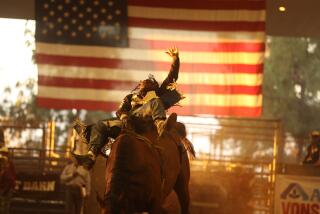Leaving a Paper Trail
- Share via
In 1923, a black rodeo performer named Bill Pickett starred in a silent western called “The Bull-Dogger.”
The film has survived, curiously enough, only on paper. Scholars believe the last complete celluloid print burned or disintegrated years ago. What remains is the poster, which includes a color illustration of Pickett, leaning against a post, a cryptic smile curling across his craggy face.
Edward Mapp, a New York-based film scholar, over the years collected 900 such posters advertising African American films from 1921 to the present. Included were silents, Hollywood musicals (“Song of the South”), obscure “race pictures” from World War II (“Blood of Jesus”), ‘70s blaxploitation films (“Shaft”) and more recent independent fare (“She’s Gotta Have It”).
Actors Paul Robeson, Lena Horne, Louis Armstrong and Sidney Poitier and directors Spencer Williams and Oscar Micheaux were among those featured.
Mapp, 66, donated the collection last month to the Margaret Herrick Library of the Academy of Motion Picture Arts and Sciences in Beverly Hills, where it expands already impressive holdings documenting the entire history of film. With the Mapp addition, the academy now has more than 17,000 movie posters. (Mapp was unavailable for comment.)
Black filmmaking “is an important subject for study,” said library director Linda Mehr. “While we have tried to be comprehensive [in our holdings], there are plenty of areas that could use more documentation. This was one of them. . . . This collection provides an enormous amount of material for research and study.”
The posters are probably most useful, film historian Donald Bogle said, for tracing the frustrations and triumphs of black actors and directors both within and outside the studio system. The Mapp collection provides “a really great chronicle of African American film,” he said.
That some of the films themselves no longer exist only increases the value of the posters, Bogle suggests.
“In the beginning, films were not taken that seriously,” he said. “Even people starring in them did not realize that people might want to see them 60 or 70 years later.”
At the time, African American performers were also not taken seriously, at least by white studio executives and audiences. Prior to the civil rights movement, black actors such as Stepin Fetchit, Bill “Bojangles” Robinson and Louise Beavers usually appeared in Hollywood films as fawning domestics, comic types or dancers.
But these performers also headlined cheaply made pictures with all-black casts. Fetchit’s 1940 vehicle “Big Timers” and similar films could draw crowds at black theaters around the country.
While technically limited, these so-called “race pictures” “had a whole different kind of feel, real and immediate, [compared to] the insulated world of Hollywood,” Bogle said.
Yet the posters for all-black films often imitated those for big studio films, especially in marketing hyperbole. The bill for the 1920s movie “The Flying Ace” promised “Six smashing reels of action! The grandest airplane thriller ever filmed!”
Beginning in the late 1940s, Hollywood slowly began featuring black characters in more varied roles. The stardom of Poitier was a turning point; his role in “The Defiant Ones” marked the first time a studio picture split top billing between a black star and a white star (Tony Curtis).
For now, the academy is centering its efforts on preserving and cataloging the posters. Many are printed on acidic paper that yellows and crumbles with age; switching to a mulberry-paper backing will allow easier handling. One afternoon this week, workers were busily scanning images into a database containing detailed information about each poster. Some of the collection will go on public display at the academy library beginning Friday, said academy spokesman Frank Lieberman.
Many of the posters are very rare, if not unique. Sometimes only several copies of posters advertising the “race pictures” from the Second World War have survived.
Archivist and dealer John Kisch, who with Mapp co-authored the 1992 book “A Separate Cinema: 50 Years of Black Cast Posters,” said many early posters can bring in between $1,000 and $15,000 at auction.
But Bogle sees a value that transcends price.
“This art,” he said, “is a dazzling visual documentation of a period in history many people don’t know much about.”
More to Read
Only good movies
Get the Indie Focus newsletter, Mark Olsen's weekly guide to the world of cinema.
You may occasionally receive promotional content from the Los Angeles Times.











